| |
For the current x-ray spectroscopy program at the ESR storage ring (GSI-Darmstadt) a position sensitive
germanium detector system has been completed. Along with a new kind of x-ray spectrometer this detector
may play a keyrole for the next step of high precision x-ray experiments, aiming on a precise test of
quantum electrodynamics in the heaviest one-electron systems such as a hydrogenlike uranium. The position
sensitive structure of the detector has been realized on an area of 47x23.4 mm2 by an array of 200 strips
(200 mm wide and 23.4 mm long) separated by 35 μm wide grooves etched through boron implanted contact.
The micro-strip detector
At the beginning a 4.1 mm thick germanium diode was produced with boron implanted front contact and about 0.6 mm
thick Li-diffused rear contact. The position sensitive structure of the detector has been realized by an array of
200 strips, each of them 200 mm wide and 23.4 mm long, separated by 35 mm wide grooves etched through the boron
implanted contact. This means that the position information can be obtained from an area of 47 x 23.4 mm2 (1100 mm2).
A guard-ring which surrounds this area enables also relatively simple assembling. Each strip has been joined to a
preamplifier placed outside of the cryostat with printed leads inside the flexible Kapton-foil. All connections between
the strips and printed leads have been performed through bonded Al-wires. The Kapton-foil pressed between two Viton-seals
serves at the same time as vacuum feedthrough. A 2 l/s Varian ion-pump maintains the pressure inside the cryostat below
5x10-7 mbar. Thorough laboratory tests were performed using 241Am γ-rays. A lot of effort is needed to avoid deterioration
of the spectra caused by ground loops, microphonics, different pick-ups and high-frequency oscillations. By proper reducing
of such effects the energy resolutions of the strips were found to be in the range of 1.6 to 1.9 keV [FWHM] for 60 keV
γ-rays using a commercial shaping amplifier with 6 ms time constant. The main contributions to this resolution, as
experimentally determined testing the system without germanium detector, are caused by Kapton-foil itself (inter-lead
capacitance and dielectric loss effects) and its capacity to the grounded cryostat. Only slightly improved resolutions
could be obtained by very careful layout of the connection elements (Kapton-foil and vacuum feedthrough), especially for
higher number of strip elements. Simultaneously with measuring the signals from the strips there is possible to process the
signals obtained from the common rear contact.
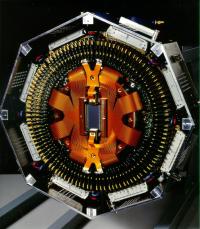
Figure 1: The main part of the detector system without the cryostat-cap and the cover for the electronics. 200 commercially available
low dissipation (50 mW) charge sensitive preamplifiers (CSPA 02.04 from KFKI-Budapest) are placed on both sides of the printed
board outside the cryostat. 100 of them are visible on the picture. The octagonal housing for the preamplifiers has a diameter
of 39 cm and 12 cm in depth. No ventilation of the housing is needed since the total thermal dissipation of the preamplifiers
amounts to only 10 W. The consumption of liquid nitrogen amounts to about 3 l/day.
Energy resolution 1.8 keV @ 60 keV
|
|
Position resolution 200 μm
|
|
Time resolution 70 ns
|
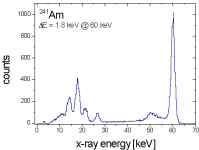
Figure 2: A sample photon spectrum recorded with one individual strip. For this purpose,
a standard 241Am γ-ray source has been used. The energy resolution achieved corresponds
to 1.8 keV [FWHM] at 60 keV.
|
|
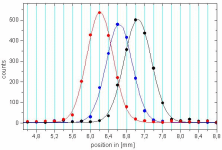
Figure 3: Position spectra obtained with a collimated γ-ray source (60 keV, 241Am) at three different
positions.
|
|
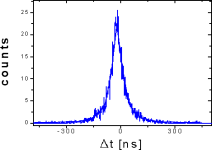
Figure 4: A sample time spectrum observed between two neighbouring segments of the micro-strip detector. Here, a time
resolution of 70 ns [FWHM] has been achieved.
|
Compton scattering and charge splitting
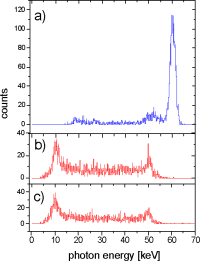
Figure 5: Reconstruction of one photon events leading to coincidences between two-neighbouring
strips. b) and c) the coincident spectra associated to the time spectrum displayed in
Fig. 3. a) Energy spectrum produced by adding the spectra b) and c) event by event.
|
For illustration we depict in Fig. 2 a sample photon spectrum recorded with one individual strip.
Here, a standard 241Am γ-ray source has been used. The energy resolution achieved corresponds to
1.8 keV [FWHM] at 60 keV whereby a shaping amplifier with 3 μs time constant has been applied.
Within this first test, the individual amplifiers for in total 32 strips were connected to 4K
CAMAC ADC modules. In addition, the time signals of each strip were recorded by using CF threshold
discriminators connected to 4K TDC CAMAC modules. Event-list readout of all strips (energy and
timing) is triggered by a signal from any strip above a threshold of approximately 5 keV. This
technique allowed us to study the coincident photon spectra between neighbouring strips as well
as to investigate the timing characteristics of the detector system used. As example, we display
in Fig. 3 a sample time spectrum observed between two strips. Here, a time resolution of 70 ns
[FWHM] is observed. Note, that for the planned experiments with heavy ion beams, a good time
resolution for the x-ray detection system is required since the photons will be exclusively
detected in coincidence with down-charged ions [3]. Since, the latter will be accomplished
by fast scintillator or multi-wire proportional counters, a time resolution of better than
50 ns should be achievable with the current micro-strip detector. This is by far sufficient
to meet the criteria of the current x-ray spectroscopy program at the storage ring ESR at GSI.
Experiment
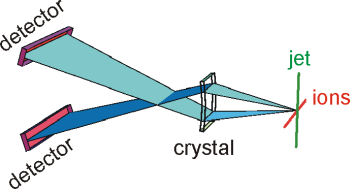 For the next generation of Lamb-Shift experiments on hydrogenlike high-Z ions at the ESR storage
ring at GSI, a new kind of a transmission x-ray spectrometer [4,5] has been designed. This
instrument exploids the focusing compensated asymmetric Laue geometry (FOCAL) which focuses the
radiation of a certain wavelength from an extended source to two single lines on the Rowland-circle.
For a certain wavelength, these Bragg reflections arising from a cylindrically curved Si-crystal
with a bending radius of 2 m. The design is optimized for photon energies in the range between 50
and 100 keV.
For the next generation of Lamb-Shift experiments on hydrogenlike high-Z ions at the ESR storage
ring at GSI, a new kind of a transmission x-ray spectrometer [4,5] has been designed. This
instrument exploids the focusing compensated asymmetric Laue geometry (FOCAL) which focuses the
radiation of a certain wavelength from an extended source to two single lines on the Rowland-circle.
For a certain wavelength, these Bragg reflections arising from a cylindrically curved Si-crystal
with a bending radius of 2 m. The design is optimized for photon energies in the range between 50
and 100 keV.
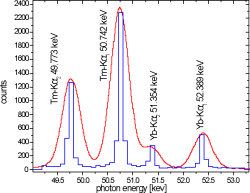
Figure 6: First preliminary result obtained with the mirco-strip detector mounted at the FOCAL
spectrometer.in comparison with an x-ray spectrum recorded with a standard Ge(i) detector
(resolution at 60 keV: about 500 eV). The intensity pattern as function of the position (energy)
identifies well resolved the two components of the Kα-doublet of Tm as well as those of the Yb.
|
In order to achieve the desired efficiency of 10-7, a position sensitive micro-strip
Ge detector appears to be the most promising photon counting system. Very recently, the micro-strip
Ge detector has been tested in combination with the FOCAL spectrometer using an intense radiactive
169Yb source. Even without any strict conditions on the photon energies for the individual strips,
the intensity pattern observed with the strip-detector as function of the position (i.e. strip-number)
indentifies clearly the two x-ray lines of the Kα-doublet of Tm and of Yb which are separated by
approximatley 970 eV and 1030 eV, respectively. This demonstrates, that in combination with the
FOCAL spectrometer, a energy resolution of close to 100 eV is achieved along with a high detection
efficiency.
References
[1] G.Rossi, J. Morse, D. Protic, "Energy and Position Resolution of Germanium Microstrip Detectors at X-Ray Energies from 15 to 100 keV", IEEE Trans. Nucl. Sci., vol. 46, no. 3, pp. 765-773, June 1999.
[2] M. Momayezi, W.K. Warburton, R. Kroeger, "Position Resolution in a Ge-Strip Detector", SPIE, vol. 3768, pp. 530-537, 1999.
[3] Th. Stöhlker, "Lamb Shift Experiments on High-Z Ions Performed at the ESR Storage Ring", Physica Scripta, T73, pp. 29-35, 1997.
[4] H.F. Beyer, "Characterization of Transmission-Type Curved-Crystal X-Ray Optics for Fast Ion-beam Spectroscopy", Nucl. Instr. Meth., A 400, pp. 137-148, 1997.
[5] H.F. Beyer at al., "The Focusing Compensated Asymmetric Laue Spectrometer", GSI-Scientific Report 1999, p. 209, 2000.
|
| |
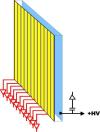






 For the next generation of Lamb-Shift experiments on hydrogenlike high-Z ions at the ESR storage
ring at GSI, a new kind of a transmission x-ray spectrometer [4,5] has been designed. This
instrument exploids the focusing compensated asymmetric Laue geometry (FOCAL) which focuses the
radiation of a certain wavelength from an extended source to two single lines on the Rowland-circle.
For a certain wavelength, these Bragg reflections arising from a cylindrically curved Si-crystal
with a bending radius of 2 m. The design is optimized for photon energies in the range between 50
and 100 keV.
For the next generation of Lamb-Shift experiments on hydrogenlike high-Z ions at the ESR storage
ring at GSI, a new kind of a transmission x-ray spectrometer [4,5] has been designed. This
instrument exploids the focusing compensated asymmetric Laue geometry (FOCAL) which focuses the
radiation of a certain wavelength from an extended source to two single lines on the Rowland-circle.
For a certain wavelength, these Bragg reflections arising from a cylindrically curved Si-crystal
with a bending radius of 2 m. The design is optimized for photon energies in the range between 50
and 100 keV.
